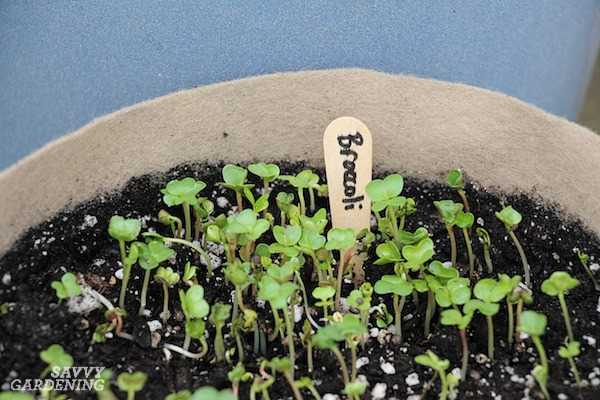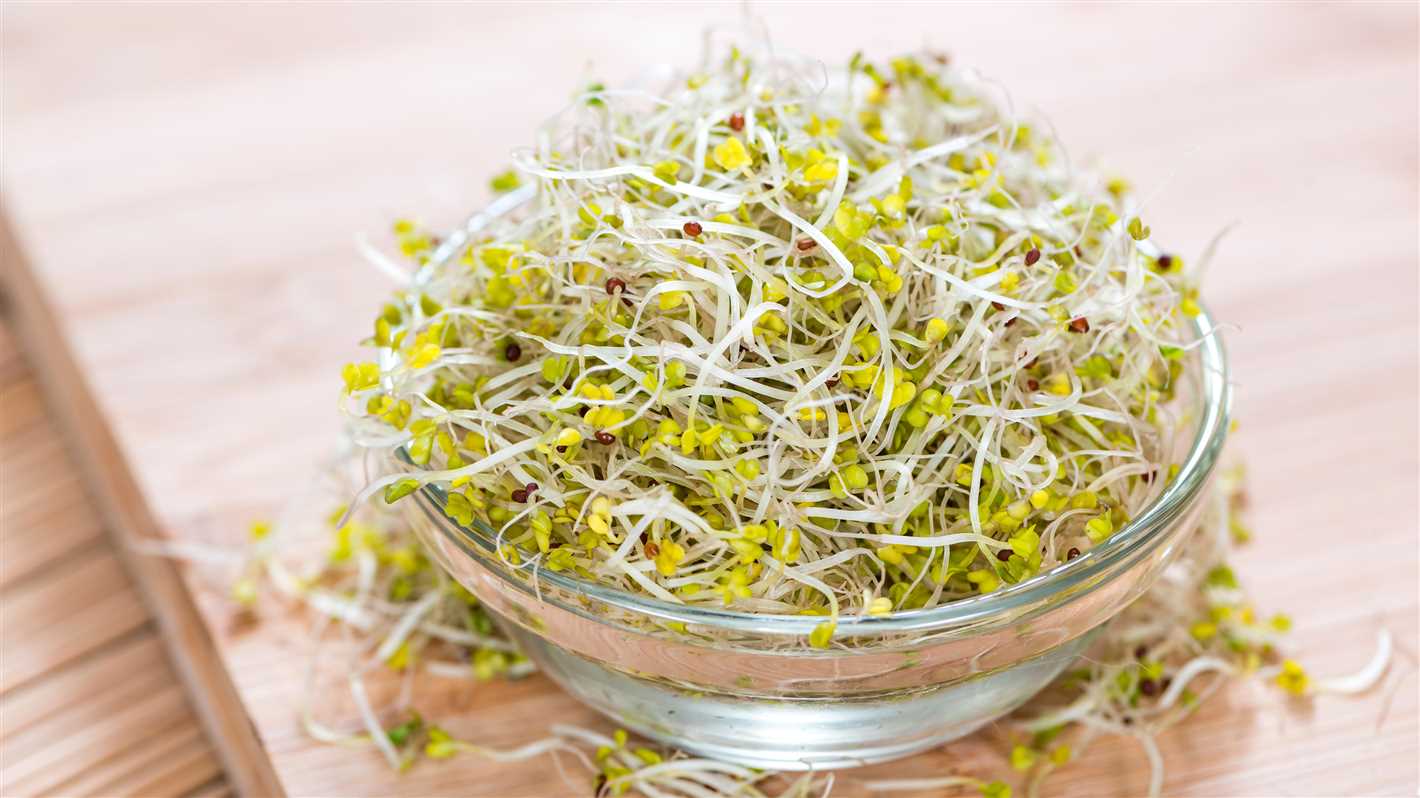- Choosing the Right Seeds
- Preparing the Soil
- 1. Location
- 2. Soil Testing
- 3. Soil Enrichment
- 4. Weed Control
- 5. Soil Moisture
- 6. Soil Fertility
- 7. Soil Preparation
- Providing Adequate Sunlight
- Optimizing Temperature and Humidity
- Temperature
- Humidity
- Watering and Drainage
- How often to water:
- Watering techniques:
- Drainage:
- Implementing Proper Nutrient Management
- Practicing Pest and Disease Control
- 1. Clean and Sanitize
- 2. Use Disease-Resistant Varieties
- 3. Proper Plant Spacing
- 4. Regular Inspections
- 5. Organic Pest Control
- 6. Crop Rotation
- 7. Weed Control
- 8. Water Management
- Harvesting and Storing Broccoli Sprouts
- 1. Timing
- 2. Preparation
- 3. Harvesting
- 4. Cleaning
- 5. Storing
- 6. Shelf life
- “Question-Answer”
- What are broccoli sprouts?
- What are the essential conditions for sowing broccoli sprouts?
- What type of soil is best for sowing broccoli sprouts?
- How much sunlight do broccoli sprouts need?
- How often should I water broccoli sprouts?
- What is the best temperature range for growing broccoli sprouts?
- How long does it take for broccoli sprouts to grow?
- “Video” How to Sprout EASILY for 25 Cents a Day! Jar Growing Method for Beginners…
Growing your own broccoli sprouts is a satisfying and nutritious way to add freshness to your meals. Broccoli sprouts are packed with vitamins, minerals, and antioxidants that promote good health. Whether you are a seasoned gardener or a beginner, providing the essential conditions for your broccoli sprouts to grow strong and healthy is crucial.
First and foremost, you need to select the right seeds for your sprouts. Look for high-quality organic broccoli seeds from a reputable source. These seeds should be specifically labeled for sprouting, as they are free from chemicals and contaminants that could hinder growth.
Next, you will need to provide your sprouts with the ideal environment to germinate. This includes a clean container, such as a sprouting tray or a wide-mouthed glass jar. The container should be thoroughly washed and sanitized before use to prevent any bacteria or mold growth.
Once you have your seeds and container ready, it’s time to sow your broccoli sprouts. Spread a layer of seeds evenly across the bottom of the container, making sure not to overcrowd them. Give the seeds a good rinse with clean water and drain off any excess moisture. Place the container in a warm and dark location, such as a kitchen cupboard or pantry.
Remember to rinse your sprouts regularly, at least twice a day, with clean water to keep them hydrated and prevent any bacterial or fungal contamination. After a few days, you will start to see the seeds sprout and grow into tiny broccoli sprouts.
As your broccoli sprouts continue to grow, they will require daylight to develop their green color and nutrients. Once they have reached the desired size, usually after 5-7 days, you can move them to a location with indirect sunlight to help them photosynthesize. This will enhance their nutritional value and flavor.
In conclusion, sowing broccoli sprouts requires attention to detail and proper care to ensure their strong and healthy growth. By selecting high-quality seeds, providing a clean and suitable environment, and giving them regular care and attention, you can enjoy the rewards of homegrown broccoli sprouts that are full of flavor and nutrition.
Choosing the Right Seeds
When it comes to sowing broccoli sprouts, choosing the right seeds is essential for strong and healthy growth. Here are some factors to consider when selecting your broccoli sprout seeds:
- Organic seeds: Choose organic seeds to ensure that your sprouts are free from any harmful pesticides or chemicals. Organic seeds are also more likely to be non-GMO, which means they haven’t been genetically modified.
- Variety: There are several varieties of broccoli sprouts available, each with its own unique flavor and characteristics. Consider the taste you prefer and the specific qualities you are looking for in your sprouts.
- Germination rate: Check the germination rate of the seeds before purchasing. This rate indicates the percentage of seeds that are likely to sprout. Look for seeds with a high germination rate to maximize your chances of successful growth.
- Freshness: Fresh seeds are more likely to sprout successfully. Check the packaging for the date of harvest or expiration and choose the freshest seeds available.
Tip: It’s a good idea to buy seeds from reputable suppliers or sources to ensure quality and reliability.
Once you have chosen the right seeds, you are one step closer to growing strong and healthy broccoli sprouts. Next, you will need to provide them with the essential conditions for growth.”
Preparing the Soil

Before sowing broccoli sprouts, it is important to prepare the soil properly to provide the best conditions for strong and healthy growth. Here are some essential steps to follow:
1. Location
Choose a location for your broccoli sprouts that receives full sun for at least 6 hours a day. Ensure that the area has good drainage and is not prone to waterlogging.
2. Soil Testing

Perform a soil test to determine the pH and nutrient levels of your soil. Broccoli sprouts prefer a slightly acidic soil with a pH range of 6.0 to 7.0. Adjust the pH if necessary by adding lime to raise it or sulfur to lower it.
3. Soil Enrichment

Broccoli sprouts thrive in fertile soil rich in organic matter. Add well-rotted compost or aged manure to improve the soil’s nutrient content and structure. Incorporate the organic matter into the soil using a garden fork or tiller.
4. Weed Control
Clear the area of any weeds or vegetation before sowing broccoli sprouts. Weeds compete with young plants for nutrients and water, so it is essential to eliminate them beforehand. Use a hoe or hand-pull the weeds, ensuring the roots are completely removed.
5. Soil Moisture
Ensure the soil is moist but not saturated before sowing broccoli sprouts. Overly wet soil can lead to poor germination and fungal diseases. If the soil is too dry, water it thoroughly a day or two before sowing to provide adequate moisture.
6. Soil Fertility
Sprinkle a balanced organic fertilizer or slow-release granular fertilizer over the prepared soil. Follow the manufacturer’s instructions for application rates and guidelines. This will provide essential nutrients to support the growth of your broccoli sprouts.
7. Soil Preparation
Using a garden rake, smooth out the soil surface and remove any large clumps or debris. Lightly compact the soil to create a firm but not compacted seedbed for sowing the sprouts.
By following these steps and preparing the soil properly, you can ensure that your broccoli sprouts have the ideal environment for strong and healthy growth.
Providing Adequate Sunlight
Broccoli sprouts require adequate sunlight to grow strong and healthy. Sunlight is essential for photosynthesis, the process in which plants convert light energy into chemical energy to fuel their growth.
When sowing broccoli sprouts, it is important to choose a location that receives at least 6-8 hours of direct sunlight per day. This can be achieved by selecting a spot in your garden or balcony that is not shaded by buildings, trees, or other obstacles.
If you are growing broccoli sprouts indoors, place them in an area with access to sunlight, such as a south-facing window. If natural light is not sufficient, you can supplement it with artificial lights specifically designed for plant growth.
It is also important to ensure that the sunlight is evenly distributed across the entire surface of the sprouts. This can be achieved by rotating the pots or trays regularly to prevent the sprouts from leaning towards the light source.
While sunlight is crucial for growth, it is important to note that excessive heat can be detrimental to the sprouts. If the temperature exceeds 80°F (27°C), the sprouts may become stressed and wilted. In such cases, providing shade during the hottest parts of the day or moving the sprouts to a cooler location can help protect them.
Optimizing Temperature and Humidity
Temperature and humidity are key factors in the successful growth of broccoli sprouts. By providing the optimal conditions for these variables, you can ensure strong and healthy growth for your sprouts.
Temperature
The ideal temperature range for growing broccoli sprouts is between 18°C (64°F) and 22°C (72°F). This temperature range promotes optimal growth and allows the sprouts to develop at a steady rate. Avoid temperatures below 12°C (54°F) or above 27°C (80°F), as extreme temperatures can negatively impact the growth and development of the sprouts.
To maintain the desired temperature, you can use a heating pad or a temperature-controlled environment such as a greenhouse. It is important to monitor the temperature regularly to ensure it stays within the optimal range for the sprouts.
Humidity
Broccoli sprouts require high humidity levels to thrive. The ideal humidity range for growing broccoli sprouts is between 70% and 80%. This level of humidity helps to prevent the sprouts from drying out and promotes healthy growth.
To increase humidity levels, you can use a humidifier or place trays of water near the sprouts. This will help maintain a moist environment and prevent the sprouts from drying out. It is important to monitor the humidity levels regularly and make adjustments as needed to ensure optimal conditions for the sprouts.
By optimizing the temperature and humidity for your broccoli sprouts, you can create the ideal growing conditions for strong and healthy growth. Remember to regularly monitor these variables and make any necessary adjustments to ensure the best possible results.
Watering and Drainage
Watering is a crucial aspect of growing broccoli sprouts. It is necessary to provide the sprouts with an adequate amount of water to support their growth and development. However, it is equally important to ensure proper drainage to prevent waterlogged soil conditions.
How often to water:
- Watering frequency will vary depending on various factors such as temperature and humidity levels.
- As a general guideline, it is recommended to water the sprouts once a day, keeping the soil consistently moist but not soaked.
- Monitor the soil moisture levels regularly by checking the top inch of the soil. If it feels dry to the touch, it is time to water.
Watering techniques:
- Use a watering can or a gentle spray nozzle to ensure even distribution of water.
- Avoid overhead watering as it can lead to fungal diseases. Instead, water the soil directly to minimize the risk of foliar diseases.
- Slow, deep watering is preferred over light and frequent watering, as it encourages deep root growth and helps the plants withstand dry periods.
Drainage:

Good drainage is essential for the health of broccoli sprouts. Excess water should be able to drain freely from the soil to prevent waterlogging, which can lead to root rot and other issues.
- Ensure that the pot or container used for growing broccoli sprouts has drainage holes at the bottom.
- Before sowing the seeds, prepare the soil by adding organic matter to improve its drainage capabilities.
- If the soil tends to get waterlogged, consider adding sand or perlite to the mix to enhance drainage.
By maintaining a proper watering schedule and ensuring adequate drainage, you can create optimal conditions for the strong and healthy growth of broccoli sprouts.
Implementing Proper Nutrient Management
Proper nutrient management is crucial for the strong and healthy growth of broccoli sprouts. By providing the right balance of nutrients, you can ensure that the sprouts develop well and yield a bountiful harvest. Here are some key considerations for implementing proper nutrient management:
- Soil Testing: Before planting your broccoli sprouts, it’s essential to conduct a soil test. This will help you determine the soil’s nutrient composition and pH levels. Understanding your soil’s nutrient levels will guide you in planning the appropriate fertilizer application.
- Choosing Fertilizers: The choice of fertilizers depends on the results of the soil test. Commonly used fertilizers for broccoli sprouts include organic compost, well-rotted manure, and balanced commercial fertilizers. Organic options are often preferred as they promote sustainable and environmentally friendly practices.
- Nitrogen Requirements: Nitrogen is a critical nutrient for broccoli sprouts. It promotes leafy growth and overall plant vigor. However, excessive nitrogen can lead to weak stems and increased susceptibility to diseases. When applying nitrogen-based fertilizers, it’s essential to strike a balance between providing enough nitrogen for robust growth and avoiding overfertilization.
- Phosphorus and Potassium: Phosphorus and potassium are important for root development, flowering, and fruit production in broccoli sprouts. Balanced fertilizers that contain these nutrients in the correct ratio are recommended for optimal growth.
- Fertilizer Application: When applying fertilizers, it’s important to follow the recommended rates and timing. Overuse of fertilizers can cause nutrient imbalances, environmental pollution, and harm to the sprouts themselves. Applying the right amount at the right time will prevent nutrient deficiencies or excesses.
- Watering: Proper watering practices are also part of nutrient management. Adequate irrigation ensures that the plants receive nutrients efficiently. Watering too much or too little can affect nutrient uptake and may lead to stunted growth or waterlogging.
- Monitoring Nutrient Levels: Regular monitoring of soil nutrient levels throughout the growth period is crucial. This helps identify any deficiencies or excesses early on, allowing for timely corrective measures. Nutrient deficiency symptoms, such as yellowing leaves or stunted growth, should be addressed promptly.
- Organic Management: If you prefer an organic approach, there are several organic fertilizers and soil amendments available that can provide the necessary nutrients for broccoli sprouts. Organic practices focus on building healthy soil ecosystems, promoting natural nutrient cycling, and reducing chemical inputs.
By implementing proper nutrient management practices, you can ensure that your broccoli sprouts grow strong and healthy, providing you with a bountiful harvest.
Practicing Pest and Disease Control
When sowing broccoli sprouts, it is important to be mindful of potential pests and diseases that can harm your plants. Taking preventive measures and practicing pest and disease control is essential for ensuring strong and healthy growth. Here are some tips to help you protect your broccoli sprouts:
1. Clean and Sanitize
Start by cleaning and sanitizing your tools, pots, and trays before sowing your broccoli seeds. This helps prevent the introduction of any pests or diseases that may be present on the surfaces.
2. Use Disease-Resistant Varieties
Choose disease-resistant varieties of broccoli sprouts to minimize the risk of infection. These varieties are bred to have natural resistance to common diseases, reducing the need for chemical treatments.
3. Proper Plant Spacing
Ensure that you provide enough space between each plant to promote airflow and reduce the risk of disease transmission. Overcrowded plants are more susceptible to diseases due to poor ventilation and increased humidity.
4. Regular Inspections
Regularly inspect your broccoli sprouts for signs of pests or diseases. Look for any unusual spots, discoloration, or damage on the leaves and stems. Early detection allows for prompt treatment and prevents the issue from spreading.
5. Organic Pest Control
Rather than relying on chemical pesticides, consider using organic pest control methods. These can include introducing beneficial insects, such as ladybugs or lacewings, that feed on common garden pests like aphids. You can also use organic pest control sprays derived from natural ingredients like neem oil or insecticidal soap.
6. Crop Rotation
Practice crop rotation by avoiding planting broccoli or other brassicas in the same area for consecutive seasons. This helps prevent the buildup of pests and diseases in the soil, as different plant families have different susceptibility levels.
7. Weed Control
Keep the area around your broccoli sprouts free from weeds, as they can compete for nutrients and provide hiding places for pests. Regular weeding and mulching can help reduce the risk of weed growth and associated problems.
8. Water Management
Avoid overwatering your broccoli sprouts, as this can create ideal conditions for fungal diseases. Water in the early morning or late afternoon to allow the foliage to dry before evening, reducing the risk of leaf diseases.
By practicing pest and disease control in your broccoli sprout garden, you can help ensure strong and healthy growth, increasing your chances of a successful harvest.
Harvesting and Storing Broccoli Sprouts
Once your broccoli sprouts have grown to the desired size, it’s time to harvest them. Follow these steps to ensure a successful harvest and proper storage of your sprouts:
1. Timing
Harvesting of broccoli sprouts should be done when the sprouts have reached a height of about 2-3 inches. This usually takes around 4-7 days after germination. Harvesting too early or too late can result in subpar sprouts.
2. Preparation
Before you begin harvesting, make sure to thoroughly wash your hands and sanitize any equipment to prevent contamination.
3. Harvesting
To harvest your broccoli sprouts, use a clean pair of scissors or a sharp knife to cut the sprouts just above the soil level. Avoid pulling or yanking the sprouts, as this can damage the remaining sprouts or the roots.
4. Cleaning
After harvesting, gently rinse the sprouts under cool, running water to remove any dirt or debris. Be careful not to damage the delicate sprouts during this process.
5. Storing
Once the sprouts are clean, transfer them to a clean, dry container or storage bag. Remove any excess moisture by patting them dry with a clean paper towel. Store the sprouts in the refrigerator to prolong their freshness.
6. Shelf life
Properly stored, broccoli sprouts can last for up to 5-7 days in the refrigerator. However, it is best to consume them as soon as possible to get the maximum nutritional benefits.
By following these steps, you can ensure that your harvested broccoli sprouts remain fresh and flavorful for longer, allowing you to enjoy their health benefits in various dishes.
“Question-Answer”
What are broccoli sprouts?
Broccoli sprouts are young, tender plants that are grown from broccoli seeds. They are typically harvested when they are around 2-3 inches tall and have developed their first set of true leaves.
What are the essential conditions for sowing broccoli sprouts?
The essential conditions for sowing broccoli sprouts include proper soil preparation, adequate sunlight, consistent watering, and optimal temperature and humidity levels. It is also important to use high-quality seeds and provide proper nutrition for strong and healthy growth.
What type of soil is best for sowing broccoli sprouts?
Broccoli sprouts do well in well-draining soil that is rich in organic matter. The soil should have a pH level between 6.0 and 7.0, which is slightly acidic to neutral. Adding compost or aged manure can help improve the fertility and structure of the soil.
How much sunlight do broccoli sprouts need?
Broccoli sprouts require at least 6-8 hours of direct sunlight each day for optimal growth. If you are growing them indoors, you can use grow lights to provide the necessary amount of light. It is important to place the sprouts in a location where they can receive consistent and even light exposure.
How often should I water broccoli sprouts?
Broccoli sprouts need to be watered consistently to keep the soil evenly moist, but not waterlogged. Depending on the temperature and humidity levels, you may need to water them every 1-2 days. It is important to avoid overwatering, as it can lead to root rot and other diseases.
What is the best temperature range for growing broccoli sprouts?
Broccoli sprouts thrive in temperatures between 60°F and 70°F (15°C and 21°C). They can tolerate slightly higher or lower temperatures, but extreme heat or cold can negatively impact their growth. It is important to provide proper ventilation and temperature control when growing them indoors.
How long does it take for broccoli sprouts to grow?
The time it takes for broccoli sprouts to grow depends on various factors such as temperature, light, and seed quality. Generally, it takes around 7-10 days for the sprouts to reach a harvestable size. However, it is important to regularly monitor their growth and adjust the conditions accordingly to ensure strong and healthy growth.







